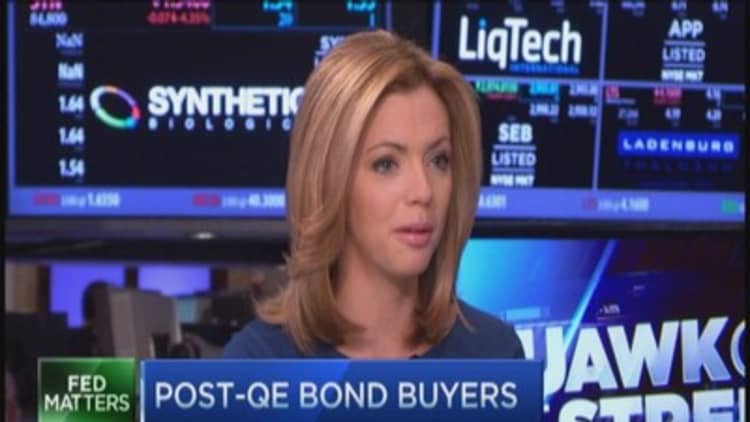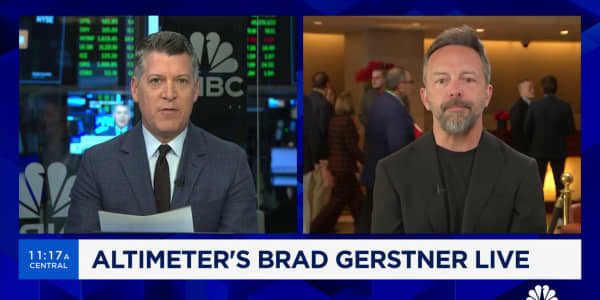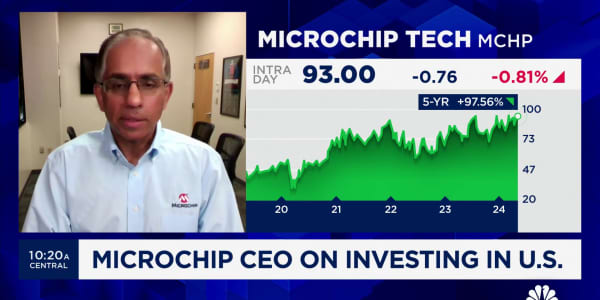
The end of the Federal Reserve's quantitative easing program and its fight against "too big to fail" banks are on a collision course in the bond market.
When quantitative easing ends in October, the market for Treasurys and mortgage-backed securities will see its biggest net buyer stepping back.
But because of new regulations requiring the country's big banks to hold more liquid assets, new buyers from Wall Street have been stepping up.
Since the "tapering" of the Fed's bond buying began in earnest in December 2013, U.S. commercial banks' holdings of Treasury and agency securities (not including mortgage-backed securities) rose to $605 billion, a 23 percent increase. Including mortgage-backed securities, that total swells to $1.97 trillion, according to data from the Federal Reserve Bank of St. Louis.
Earlier this year, the Fed finalized a rule requiring banks to hold enough liquid, easy-to-sell assets to cover 30 days of operations should the economy get in a bind again. The rule, called the "liquidity coverage ratio," requires banks to be mostly compliant by January 2015 and fully compliant by 2017.
Read MoreEnd of QE as we know it? Fed turns eye to next phase
Bank of America has made the most noticeable balance sheet changes in that effort. The Charlotte, North Carolina-based lender held $2.8 billion in Treasurys on its balance sheet at the end of the third quarter in 2013; a year later, that balance swelled by a factor of 20 to $57.5 billion, according to recent earnings reports.
Other banks don't break out so-called available-for-sale assets in readily available earnings announcements but do bury them in some form in other regulatory filings. Citigroup, for instance, had increased its Treasury balance by 30 percent to $88 billion for 12 months ending June 2014.
"Banks will continue to buy," said Peter Tchir, managing director of macro strategy at Brean Capital. Tchir said firms will shift holdings from investment-grade bonds and loans into Treasurys, largely for regulatory purposes. "They help on the liquid capital rules and are easy to manage."
Read MoreWhy the market is losing its faith in the Fed
Bank of America CFO Bruce Thompson said on the company's third-quarter earnings call that the bank is targeting its purchases toward bonds that mature in the next "four to five years" in order to manage interest-rate risk. In October, roughly a third of the Fed's targeted purchases fell in that range.
Tchir pointed out that the Fed's average holding has a maturity of about nine years, so there could be some mismatch along the curve.
Even so, a brand new set of banks may be set to embark on a similar government bond shopping spree, if impending regulations are any sign.
Read More
A liquidity requirement out of the industry's Basel consortium is similar to the rule the Fed passed this year, but will take two additional years to implement. The European Commission this summer reportedly gave a reprieve to European Union banks, pushing out the beginning of the implementation until October 2015. The rule is expected to be fully in effect in January 2019.
Additionally, a mid-November meeting of G20 leaders and finance ministers in Brisbane, Australia, will evaluate regulations requiring all global banks of a certain size to hold a large buffer of capital—up to 20 percent in excess capital—against risky assets.
To build those buffers, international banks would need to raise hundreds of billions of dollars in capital, analysts at Barclays and AllianceBernstein, among others, have said. Many banks could easily issue equity or debt to satisfy the various requirements, and others could stock up on AA-rated sovereign bonds.
Turns out battling "too big to fail" might have some behind-the-scenes benefits.





